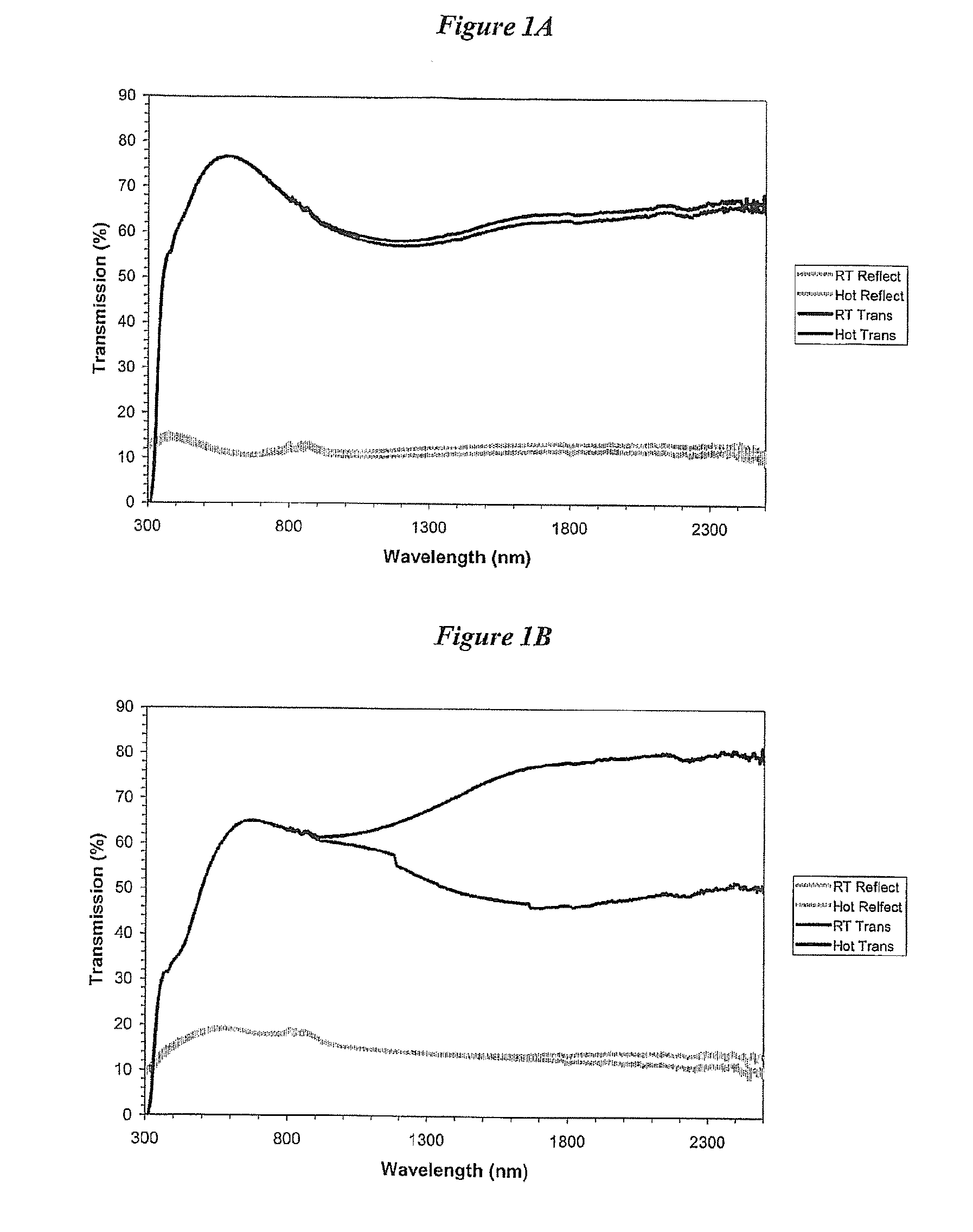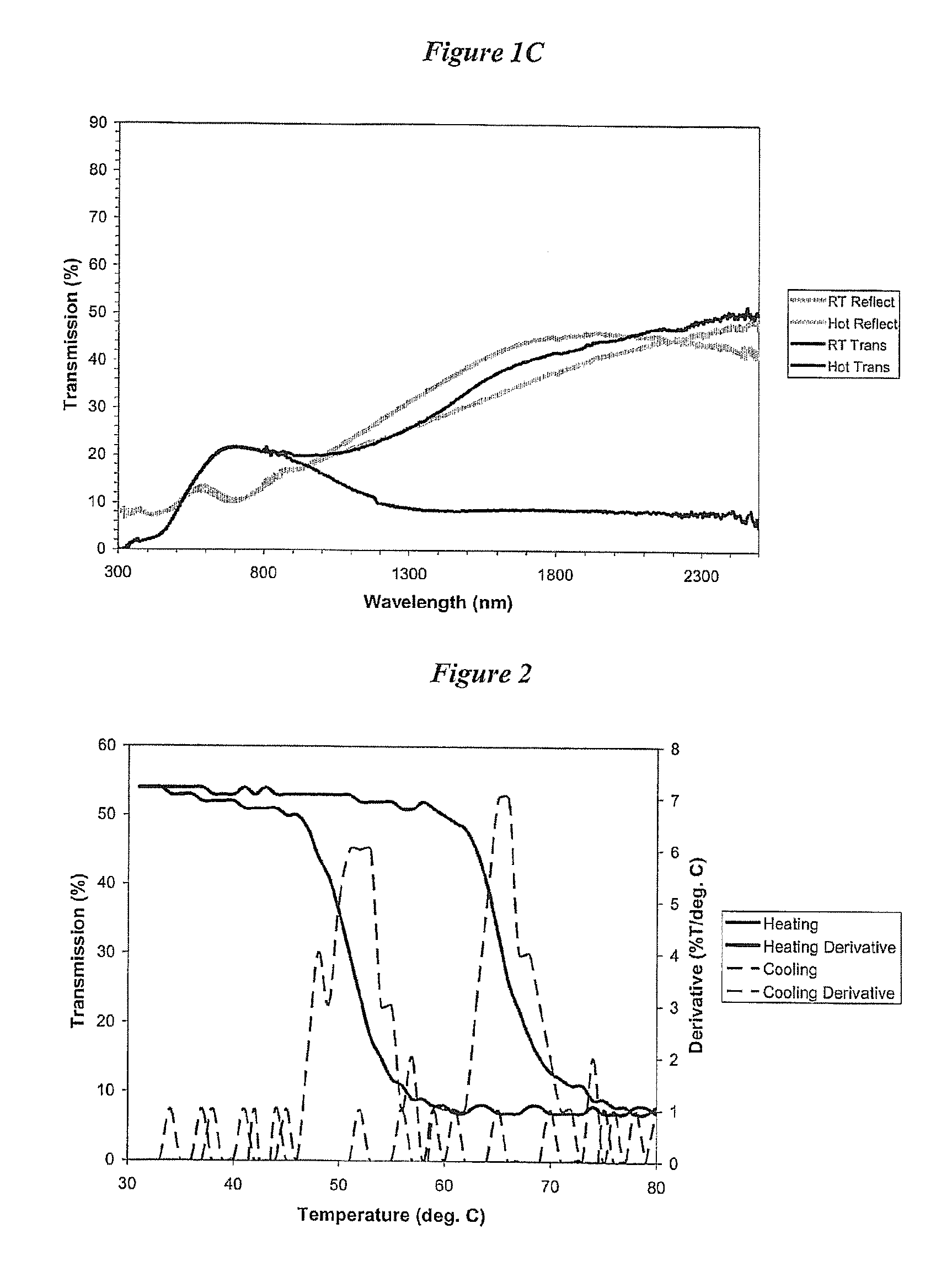Thermochromic coatings ii
a technology of thermochromic coating and film thickness, applied in the direction of instruments, optical elements, conductors, etc., can solve the problems of imposing additional demands on the temperature stability of materials, significant heating of windows, thermal discomfort, etc., and achieves the effect of increasing the film thickness, increasing the magnitude of the difference, and decreasing the optical transmission
- Summary
- Abstract
- Description
- Claims
- Application Information
AI Technical Summary
Benefits of technology
Problems solved by technology
Method used
Image
Examples
example 1
[0095]Initial experiments were carried out using similar conditions utilized previously for the deposition of tungsten doped VO2 films [20 & 21], however it was found that reaction using [VOCl3] almost invariably produced films of V2O5. This is not surprising given that [VOCl3] contains vanadium(V). Therefore it was determined early on to optimize conditions using [VCl4] as the vanadium precursor. The previous work using [VCl4] as the vanadium source was done with a plain nitrogen flow of approximately 2 L / min. Under these conditions it was found that the results were unpredictable, with films containing variable mixtures of VO2 and V2O5. It was therefore decided to examine the reaction of [VCl4] with H2O at higher N2 plain flow levels of 10 L / min with a view to optimizing the deposition such that it was fully compatible with the use of [WCl6] as the tungsten precursor. This approach instantly brought rewards, not only in terms of reproducibility, but also in terms of the phase depo...
example 2
[0097]Having determined approximate conditions that produced much higher quality thin films of VO2 than seen in previous research it was thought necessary to determine the change in optical and functional properties with film thickness. Both properties are critical in deploying a coating for use in architectural glass. The functional properties are an essential part of the product but VO2 is a highly coloured material and therefore absorbs in the visible region of the electromagnetic spectrum. To be successfully deployed in architectural glass solutions the overall visible transmission can not be too low, a figure of about 60% optical transmission is considered the minimum necessary that is likely to be viable for the coating to be adopted as a product. Further films were deposited on glass and to vary the film thickness the deposition time was varied between 10 seconds and 90 seconds. Once deposited the films were analysed for optical and functional properties by measuring the room...
example 3
Optimization
[0104]It was necessary to optimize the ratio of water to [VCl4]. The conditions used were identical to previously, that is the [VCl4] bubbler was set to 50° C. with a flow rate of 0.4 L / min N2, a plain flow of 10 L / min, a mixing chamber temperature of 150° C. and a reactor temperature of 550° C. To vary the [VCl4]:H2O ratio the speed of the syringe driver injecting the H2O from a 250 μL syringe was varied (Table 1).
TABLE 1molar flows and reactor concentrations for low, medium and high water conditions[VCl4] molarReactor VH2O molarReactor Oflow rateconcentrationflow rateconcentration[VCl4]:H2OSystem(mol / min)mol / dm3 N2(mol / min)mol / dm3 N2ratioLow Water0.000444 × 10−50.0011 1 × 10−41:2.5(CB328)Medium0.000444 × 10−50.00131.2 × 10−41:3Water(CB329)High Water0.000444 × 10−50.00181.6 × 10−41:4(CB322)
[0105]Upon carrying out these reactions it was noticed immediately that the appearance of the films changed. The film deposited using low amounts of water was brown in appearance and...
PUM
| Property | Measurement | Unit |
|---|---|---|
| thermochromic switching temperature | aaaaa | aaaaa |
| thermochromic switching temperature | aaaaa | aaaaa |
| thermochromic switching temperature | aaaaa | aaaaa |
Abstract
Description
Claims
Application Information
 Login to View More
Login to View More - Generate Ideas
- Intellectual Property
- Life Sciences
- Materials
- Tech Scout
- Unparalleled Data Quality
- Higher Quality Content
- 60% Fewer Hallucinations
Browse by: Latest US Patents, China's latest patents, Technical Efficacy Thesaurus, Application Domain, Technology Topic, Popular Technical Reports.
© 2025 PatSnap. All rights reserved.Legal|Privacy policy|Modern Slavery Act Transparency Statement|Sitemap|About US| Contact US: help@patsnap.com



